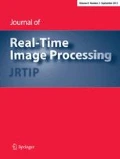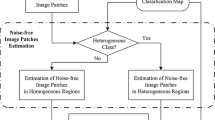Abstract
The earlier works in the context of sparsity-driven SAR imaging have shown significant improvement in the reconstruction process due to admitting sparsity as a prior. In spite of the importance of real-time processing requirement in the remote sensing (RS) applications, most of the works have not focused on real-time procedures and reducing the computational burden, but rather enhancing the quality of formed image. To address this weakness, this paper presents a problem-driven algorithm, which relies on Majorization–Minimization (MM) procedure. Using MM in our solutions, a simpler surrogate optimization problem is solved instead of the difficult original form. To show the efficacy of MM algorithm in real-time applications experimental results based on simulated and real data along with a performance analysis are presented. All results validate the superiority of the proposed MM-based method in terms of computational load and processing time as compared with previous works.
















Similar content being viewed by others
References
Atoche, A.C., Shkvarko, Y., Roman, D.T., Meana, H.P.: Convex regularization-based hardware/software co-design for real-time enhancement of remote sensing imagery. J. Real-Time Image Proc. 4(3), 261–272 (2009)
Atoche, A.C., Alvarez, R.C., Marrufo, O.P., Castillo, J.V.: An efficient systolic array grid-based structure of the robust Bayesian regularization technique for real-time enhanced imaging in uncertain remote sensing environment. J. Real-Time Image Proc. 13(4), 783–796 (2017)
Bi, H., Bi, G., Zhang, B., Hong, W., Wu, Y.: From theory to application: real-time sparse SAR imaging. ITGRS 58(4), 2928–2936 (2020)
Parrilli, S., Poderico, M., Angelino, C.V., Verdoliva, L.: A nonlocal SAR image denoising algorithm based on LLMMSE wavelet shrinkage. IEEE Trans. Geosci. Remote Sens. 50(2), 606–616 (2011)
Lobry, S., Denis, L., Tupin, F.: Multitemporal SAR image decomposition into strong scatterers, background, and speckle. IEEE J Select Top Appl Earth Obser Remote Sens 9(8), 3419–3429 (2016)
Carrara, W.G.: Soptlight Synthetic Aperture Radar. (1995).
Samadi, S., Çetin, M., Masnadi-Shirazi, M.A.: Multiple feature-enhanced SAR imaging using sparsity in combined dictionaries. IEEE Geosci. Remote Sens. Lett. 10(4), 821–825 (2012)
Moradikia, M., Samadi, S., Cetin, M.: Joint SAR imaging and multi-feature decomposition from 2-D under-sampled data via low-rankness plus sparsity priors. IEEE Trans Comput Imaging 5(1), 1–16 (2018)
Çetin, M., Karl, W.C.: Feature-enhanced synthetic aperture radar image formation based on nonquadratic regularization. IEEE Trans. Image Process. 10(4), 623–631 (2001)
Samadi, S., Çetin, M., Masnadi-Shirazi, M.A.: Sparse representation-based synthetic aperture radar imaging. IET Radar Sonar Navig. 5(2), 182–193 (2011)
Gower, R.M., Richtárik, P.: Randomized quasi-Newton updates are linearly convergent matrix inversion algorithms. SIAM J Matrix Anal Appl 38(4), 1380–1409 (2017)
Figueiredo, M.A., Nowak, R.D., Wright, S.J.: Gradient projection for sparse reconstruction: application to compressed sensing and other inverse problems. IEEE J Select Top Signal Process 1(4), 586–597 (2007)
Kim, D., Fessler, J.A.: Optimized first-order methods for smooth convex minimization. Math. Program. 159(1–2), 81–107 (2016)
Walia, A.S.: Types of optimization algorithms used in neural networks and ways to optimize gradient descent. Towards Data Science (2017).
Gil, A., Segura, J., Temme, N.M.: Numerical methods for special functions, vol. 99. Siam, (2007)
Sun, Y., Babu, P., Palomar, D.P.: Majorization-minimization algorithms in signal processing, communications, and machine learning. IEEE Trans. Signal Process. 65(3), 794–816 (2016)
Haelterman, R.: Analytical study of the least squares quasi-Newton method for interaction problems. Ghent University (2009)
Chouzenoux, E., Jezierska, A., Pesquet, J.-C., Talbot, H.: A majorize-minimize subspace approach for \ell_2-\ell_0 image regularization. SIAM J Imaging Sci 6(1), 563–591 (2013)
Figueiredo, M.A., Bioucas-Dias, J.M., Nowak, R.D.: Majorization–minimization algorithms for wavelet-based image restoration. IEEE Trans. Image Process. 16(12), 2980–2991 (2007)
Giles, D.: The majorization minimization principle and some applications in convex optimization. (2015).
Wu, Z.-J., Xu, T.-L., Zhou, Z.-Q., Wang, C.-X.: Fast algorithms for designing complementary sets of sequences under multiple constraints. IEEE Access 7, 50041–50051 (2019)
Hu, Y., Lingala, S.G., Jacob, M.: A fast majorize–minimize algorithm for the recovery of sparse and low-rank matrices. IEEE Trans. Image Process. 21(2), 742–753 (2011)
Chouzenoux, E., Idier, J., Moussaoui, S.: A majorize–minimize strategy for subspace optimization applied to image restoration. IEEE Trans. Image Process. 20(6), 1517–1528 (2010)
Hunter, D.R., Lange, K.: A tutorial on MM algorithms. Am Stat 58(1), 30–37 (2004)
Jardim, S.V.: Sparse and robust signal reconstruction. Theory Appl. Math. Comput. Sci. 5(1), 1–19–11–19 (2015).
Selesnick, I.: Total variation denoising (an MM algorithm). NYU Polytech. Sch. Eng. Lecture Notes 32 (2012).
Florescu, A., Chouzenoux, E., Pesquet, J.-C., Ciuciu, P., Ciochina, S.: A majorize-minimize memory gradient method for complex-valued inverse problems. Signal Process 103, 285–295 (2014)
Ran, R.-S., Huang, T.-Z., Liu, X.-P., Gu, T.-X.: An inversion algorithm for general tridiagonal matrix. Appl. Math. Mech. 30(2), 247–253 (2009).
Tan, L.S.: Explicit inverse of tridiagonal matrix with applications in autoregressive modelling. IMA J Appl Math 84(4), 679–695 (2019)
Munson, D.C., O'brien, J.D., Jenkins, W.K.: A tomographic formulation of spotlight-mode synthetic aperture radar. Proc IEEE 71(8), 917–925 (1983).
Grgic, S., Grgic, M., Zovko-Cihlar, B.: Performance analysis of image compression using wavelets. IEEE Trans. Industr. Electron. 48(3), 682–695 (2001)
Gao, K., Zhu, J., Xu, Z.: Majorization–minimization-based target localization problem from range measurements. IEEE Commun. Lett. 24(3), 558–562 (2020)
Jyothi, R., Babu, P., Bahl, R.: Novel algorithms based on majorization minimization for nonnegative matrix factorization. IEEE Access 7, 115682–115695 (2019)
Boyd, S., Parikh, N., Chu, E.: Distributed optimization and statistical learning via the alternating direction method of multipliers. Now Publishers Inc, (2011)
Dong, X., Zhang, Y.: A novel compressive sensing algorithm for SAR imaging. IEEE J Select Top Appl Earth Obser Remote Sens 7(2), 708–720 (2013)
Bu, H., Tao, R., Bai, X., Zhao, J.: A novel SAR imaging algorithm based on compressed sensing. IEEE Geosci. Remote Sens. Lett. 12(5), 1003–1007 (2014)
Author information
Authors and Affiliations
Corresponding author
Additional information
Publisher's Note
Springer Nature remains neutral with regard to jurisdictional claims in published maps and institutional affiliations.
Appendices
Appendix A (Proof of Eq. (13)):
To reach the solution of (13), we first resort the complex-valued derivative rules and obtain the first order derivation of \({S}_{t}\left(\mathbf{f}\right)\), given by.
Remarkably, both terms of \(\frac{{\uplambda }_{1}^{2}}{2}{\Vert {\mathbf{f}}_{k}\Vert }_{1}\) and \(\frac{{\uplambda }_{2}^{2}}{2}{\Vert \mathbf{D}\left|{\mathbf{f}}_{k}\right|\Vert }_{1}\) in (12) depend on \(\mathbf{f}\) at previous iteration and thus they are fixed with respect to \(\mathbf{f}\) at current iteration. Consequently, they don't have any impacts on the derivation procedure.
By equating (A-1) to zero the solution of (13) is simply resulted.
Appendix B (Proof of Eq. (19))
The cosine terms in (18) can be incorporated to a single cosine through phasor addition rule. To do so, the phasor expressions of the terms \(\mathbf{c}\mathbf{o}\mathbf{s}\left({\varvec{\Phi}}\right)\) and \(\mathbf{c}\mathbf{o}\mathbf{s}\left({\varvec{\Phi}}-\frac{\uppi }{2}\right)\) within (18) are given as follows
Using (B-1) and (B-2) the term \({\left(\mathbf{c}\mathbf{o}\mathbf{s}\left({\varvec{\Phi}}\right)\right)}^{T}.\mathfrak{N}{e}\left\{{\mathbf{B}}^{H}{\mathbf{H}}^{H}\mathbf{y}\right\}+{\left(\mathbf{c}\mathbf{o}\mathbf{s}\left({\varvec{\Phi}}-\frac{\uppi }{2}\right)\right)}^{T}.\mathfrak{I}\mathrm{m}\left\{{\mathbf{B}}^{H}{\mathbf{H}}^{H}\mathbf{y}\right\}\) within (18) is equivalent to the following expression.
where two vectors of \({\varvec{\zeta}}\in {\mathbb{R}}^{I\times 1}\) and \({{\varvec{\zeta}}}^{{{\prime}}}\in {\mathbb{R}}^{I\times 1}\) are, respectively, defined as \({\varvec{\zeta}}\triangleq \mathfrak{N}{e}\left\{{\mathbf{B}}^{H}{\mathbf{H}}^{H}\mathbf{y}\right\}\) and \({{\varvec{\zeta}}}^{{{\prime}}}\triangleq \mathfrak{I}\mathrm{m}\left\{{\mathbf{B}}^{H}{\mathbf{H}}^{H}\mathbf{y}\right\}\).
By expanding the above formula, we have
By finding the magnitude and the phase of each term within (B-4), the above equation can be re-expressed in new format as follows.
To minimize (19), each of cosine term within (B-5) should be maximized and accordingly we must have \({\left.{\Omega }_{i}\right|}_{i=1}^{I}=0\). By doing so, each \({\left.{\phi }_{i}\right|}_{i=1}^{I}\) can be estimated as below.
By defining the vector of \(\widehat{{\varvec{\Phi}}}\triangleq {\left[{\widehat{\phi }}_{1},{\widehat{\phi }}_{2},\dots ,{\widehat{\phi }}_{I}\right]}^{T}\), comprised of the entire phase values, (B-6) can be reformulated as.
Rights and permissions
About this article
Cite this article
Asadipooya, A., Samadi, S., Moradikia, M. et al. Majorization–Minimization approach for real-time enhancement of sparsity-driven SAR imaging. J Real-Time Image Proc 18, 1441–1455 (2021). https://doi.org/10.1007/s11554-021-01076-0
Received:
Accepted:
Published:
Issue Date:
DOI: https://doi.org/10.1007/s11554-021-01076-0




